Dining Experience and Customer Satisfaction: Literature Review
VerifiedAdded on 2023/03/20
|7
|1382
|98
Literature Review
AI Summary
This literature review examines the multifaceted aspects of customer satisfaction within the restaurant industry. It delves into the mediating role of consumption emotions in restaurant business operations, exploring how perceived utilitarian and hedonic values impact customer satisfaction, particularly in ethnic restaurants. Furthermore, the review analyzes the influence of dining atmospherics and perceived food quality on customer re-patronage intentions, emphasizing the interplay of food quality, dining environment, and customer emotions. The study also investigates the relationship between meal experiences, customer perceptions, and dark dining, highlighting the sensory dimensions of the dining experience. Finally, the review considers the role of customers in value creation, underscoring their significance in shaping dining experiences and influencing behavioral intentions. The review concludes by identifying gaps in the literature, particularly regarding specific customer preferences, such as fine dining versus food quality, offering avenues for future research.
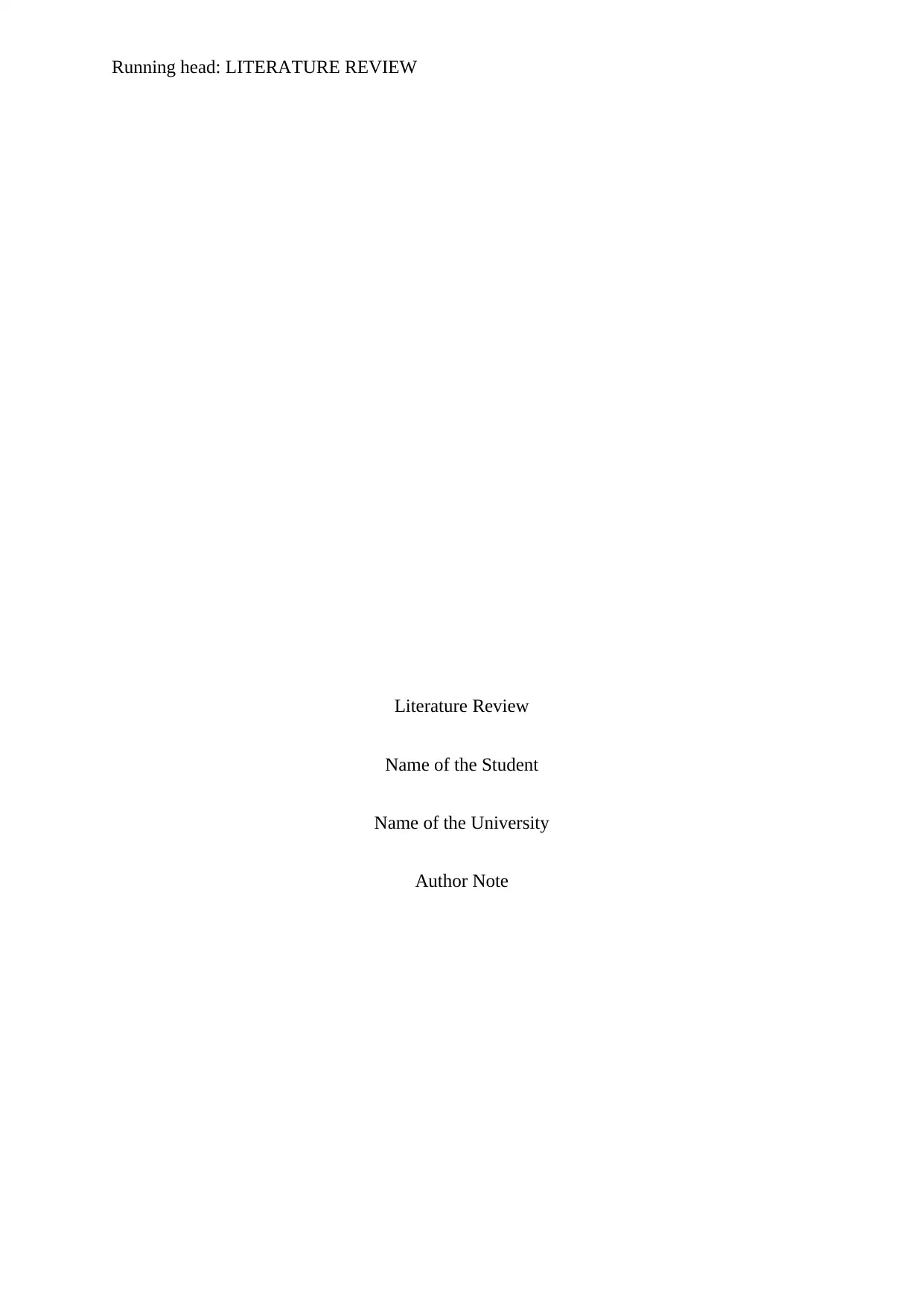
Running head: LITERATURE REVIEW
Literature Review
Name of the Student
Name of the University
Author Note
Literature Review
Name of the Student
Name of the University
Author Note
Paraphrase This Document
Need a fresh take? Get an instant paraphrase of this document with our AI Paraphraser
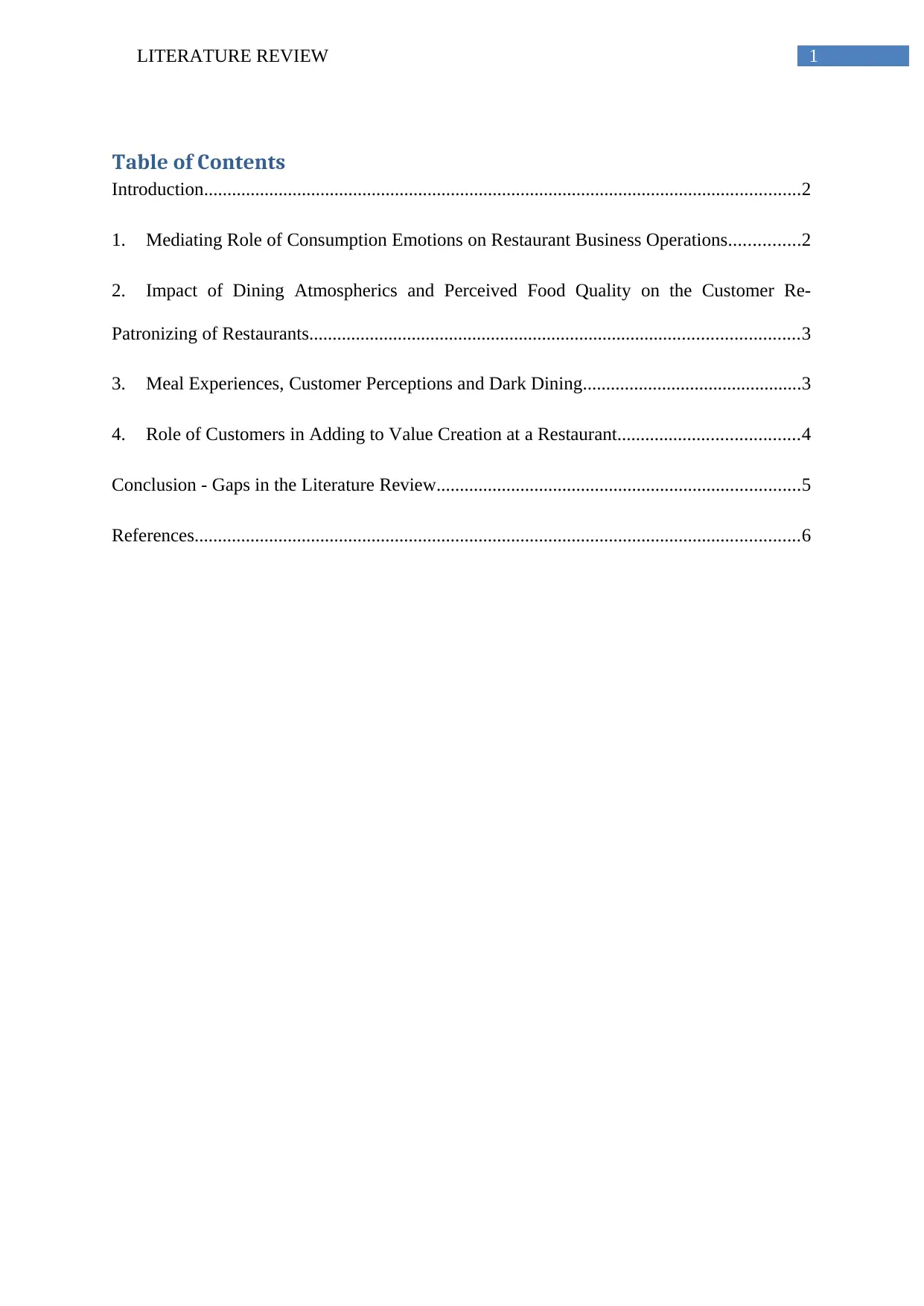
1LITERATURE REVIEW
Table of Contents
Introduction................................................................................................................................2
1. Mediating Role of Consumption Emotions on Restaurant Business Operations...............2
2. Impact of Dining Atmospherics and Perceived Food Quality on the Customer Re-
Patronizing of Restaurants.........................................................................................................3
3. Meal Experiences, Customer Perceptions and Dark Dining...............................................3
4. Role of Customers in Adding to Value Creation at a Restaurant.......................................4
Conclusion - Gaps in the Literature Review..............................................................................5
References..................................................................................................................................6
Table of Contents
Introduction................................................................................................................................2
1. Mediating Role of Consumption Emotions on Restaurant Business Operations...............2
2. Impact of Dining Atmospherics and Perceived Food Quality on the Customer Re-
Patronizing of Restaurants.........................................................................................................3
3. Meal Experiences, Customer Perceptions and Dark Dining...............................................3
4. Role of Customers in Adding to Value Creation at a Restaurant.......................................4
Conclusion - Gaps in the Literature Review..............................................................................5
References..................................................................................................................................6
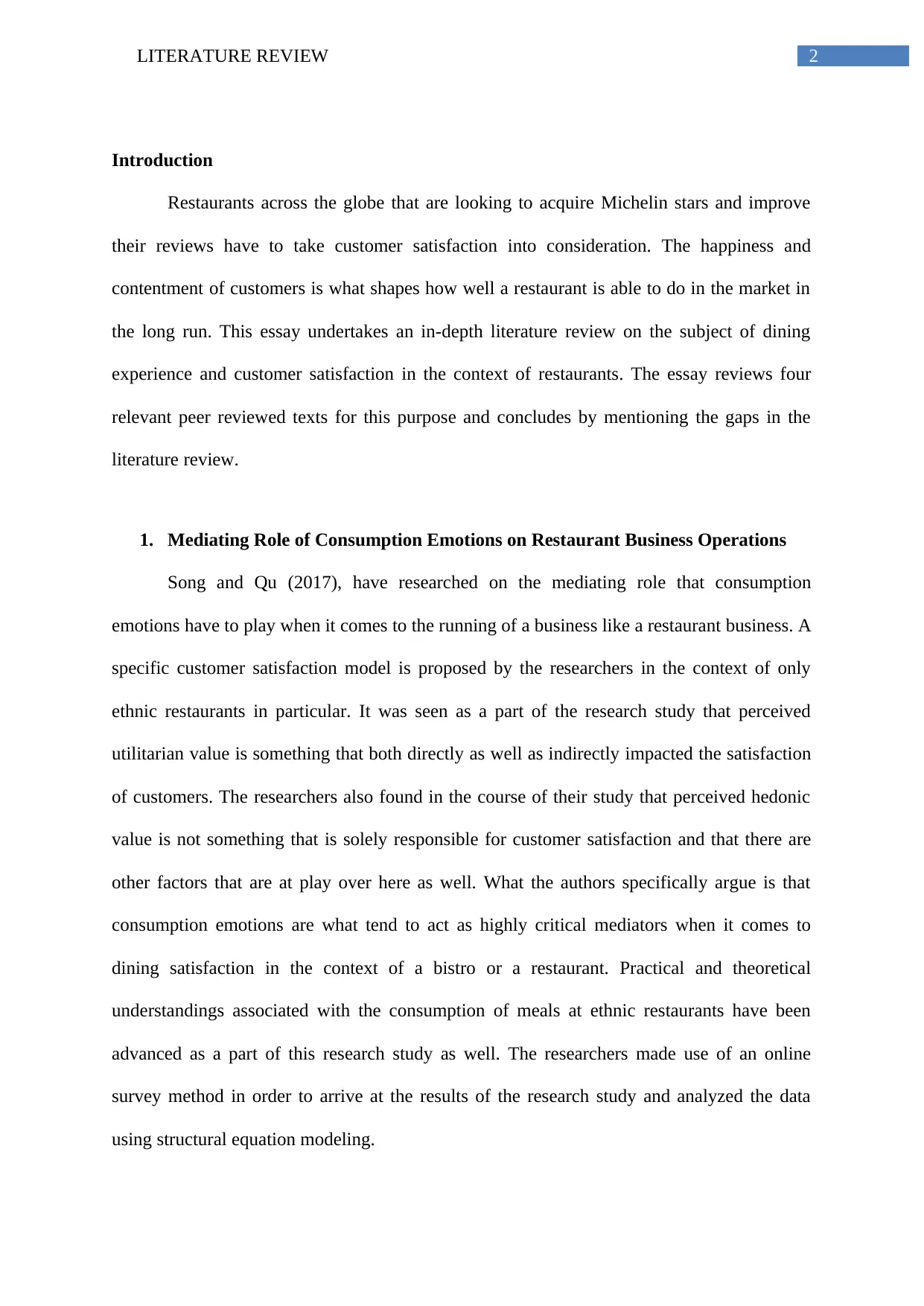
2LITERATURE REVIEW
Introduction
Restaurants across the globe that are looking to acquire Michelin stars and improve
their reviews have to take customer satisfaction into consideration. The happiness and
contentment of customers is what shapes how well a restaurant is able to do in the market in
the long run. This essay undertakes an in-depth literature review on the subject of dining
experience and customer satisfaction in the context of restaurants. The essay reviews four
relevant peer reviewed texts for this purpose and concludes by mentioning the gaps in the
literature review.
1. Mediating Role of Consumption Emotions on Restaurant Business Operations
Song and Qu (2017), have researched on the mediating role that consumption
emotions have to play when it comes to the running of a business like a restaurant business. A
specific customer satisfaction model is proposed by the researchers in the context of only
ethnic restaurants in particular. It was seen as a part of the research study that perceived
utilitarian value is something that both directly as well as indirectly impacted the satisfaction
of customers. The researchers also found in the course of their study that perceived hedonic
value is not something that is solely responsible for customer satisfaction and that there are
other factors that are at play over here as well. What the authors specifically argue is that
consumption emotions are what tend to act as highly critical mediators when it comes to
dining satisfaction in the context of a bistro or a restaurant. Practical and theoretical
understandings associated with the consumption of meals at ethnic restaurants have been
advanced as a part of this research study as well. The researchers made use of an online
survey method in order to arrive at the results of the research study and analyzed the data
using structural equation modeling.
Introduction
Restaurants across the globe that are looking to acquire Michelin stars and improve
their reviews have to take customer satisfaction into consideration. The happiness and
contentment of customers is what shapes how well a restaurant is able to do in the market in
the long run. This essay undertakes an in-depth literature review on the subject of dining
experience and customer satisfaction in the context of restaurants. The essay reviews four
relevant peer reviewed texts for this purpose and concludes by mentioning the gaps in the
literature review.
1. Mediating Role of Consumption Emotions on Restaurant Business Operations
Song and Qu (2017), have researched on the mediating role that consumption
emotions have to play when it comes to the running of a business like a restaurant business. A
specific customer satisfaction model is proposed by the researchers in the context of only
ethnic restaurants in particular. It was seen as a part of the research study that perceived
utilitarian value is something that both directly as well as indirectly impacted the satisfaction
of customers. The researchers also found in the course of their study that perceived hedonic
value is not something that is solely responsible for customer satisfaction and that there are
other factors that are at play over here as well. What the authors specifically argue is that
consumption emotions are what tend to act as highly critical mediators when it comes to
dining satisfaction in the context of a bistro or a restaurant. Practical and theoretical
understandings associated with the consumption of meals at ethnic restaurants have been
advanced as a part of this research study as well. The researchers made use of an online
survey method in order to arrive at the results of the research study and analyzed the data
using structural equation modeling.
⊘ This is a preview!⊘
Do you want full access?
Subscribe today to unlock all pages.

Trusted by 1+ million students worldwide
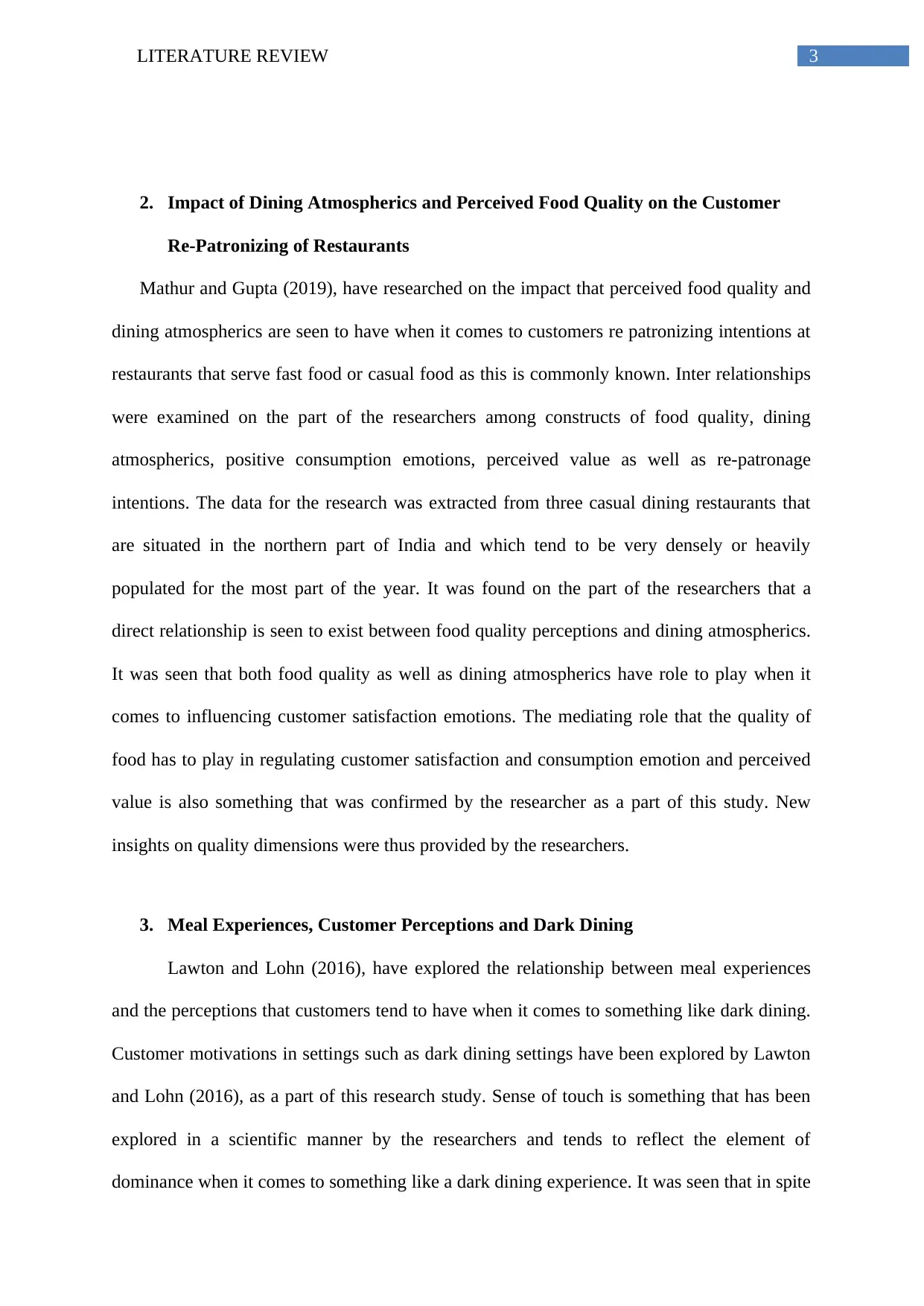
3LITERATURE REVIEW
2. Impact of Dining Atmospherics and Perceived Food Quality on the Customer
Re-Patronizing of Restaurants
Mathur and Gupta (2019), have researched on the impact that perceived food quality and
dining atmospherics are seen to have when it comes to customers re patronizing intentions at
restaurants that serve fast food or casual food as this is commonly known. Inter relationships
were examined on the part of the researchers among constructs of food quality, dining
atmospherics, positive consumption emotions, perceived value as well as re-patronage
intentions. The data for the research was extracted from three casual dining restaurants that
are situated in the northern part of India and which tend to be very densely or heavily
populated for the most part of the year. It was found on the part of the researchers that a
direct relationship is seen to exist between food quality perceptions and dining atmospherics.
It was seen that both food quality as well as dining atmospherics have role to play when it
comes to influencing customer satisfaction emotions. The mediating role that the quality of
food has to play in regulating customer satisfaction and consumption emotion and perceived
value is also something that was confirmed by the researcher as a part of this study. New
insights on quality dimensions were thus provided by the researchers.
3. Meal Experiences, Customer Perceptions and Dark Dining
Lawton and Lohn (2016), have explored the relationship between meal experiences
and the perceptions that customers tend to have when it comes to something like dark dining.
Customer motivations in settings such as dark dining settings have been explored by Lawton
and Lohn (2016), as a part of this research study. Sense of touch is something that has been
explored in a scientific manner by the researchers and tends to reflect the element of
dominance when it comes to something like a dark dining experience. It was seen that in spite
2. Impact of Dining Atmospherics and Perceived Food Quality on the Customer
Re-Patronizing of Restaurants
Mathur and Gupta (2019), have researched on the impact that perceived food quality and
dining atmospherics are seen to have when it comes to customers re patronizing intentions at
restaurants that serve fast food or casual food as this is commonly known. Inter relationships
were examined on the part of the researchers among constructs of food quality, dining
atmospherics, positive consumption emotions, perceived value as well as re-patronage
intentions. The data for the research was extracted from three casual dining restaurants that
are situated in the northern part of India and which tend to be very densely or heavily
populated for the most part of the year. It was found on the part of the researchers that a
direct relationship is seen to exist between food quality perceptions and dining atmospherics.
It was seen that both food quality as well as dining atmospherics have role to play when it
comes to influencing customer satisfaction emotions. The mediating role that the quality of
food has to play in regulating customer satisfaction and consumption emotion and perceived
value is also something that was confirmed by the researcher as a part of this study. New
insights on quality dimensions were thus provided by the researchers.
3. Meal Experiences, Customer Perceptions and Dark Dining
Lawton and Lohn (2016), have explored the relationship between meal experiences
and the perceptions that customers tend to have when it comes to something like dark dining.
Customer motivations in settings such as dark dining settings have been explored by Lawton
and Lohn (2016), as a part of this research study. Sense of touch is something that has been
explored in a scientific manner by the researchers and tends to reflect the element of
dominance when it comes to something like a dark dining experience. It was seen that in spite
Paraphrase This Document
Need a fresh take? Get an instant paraphrase of this document with our AI Paraphraser
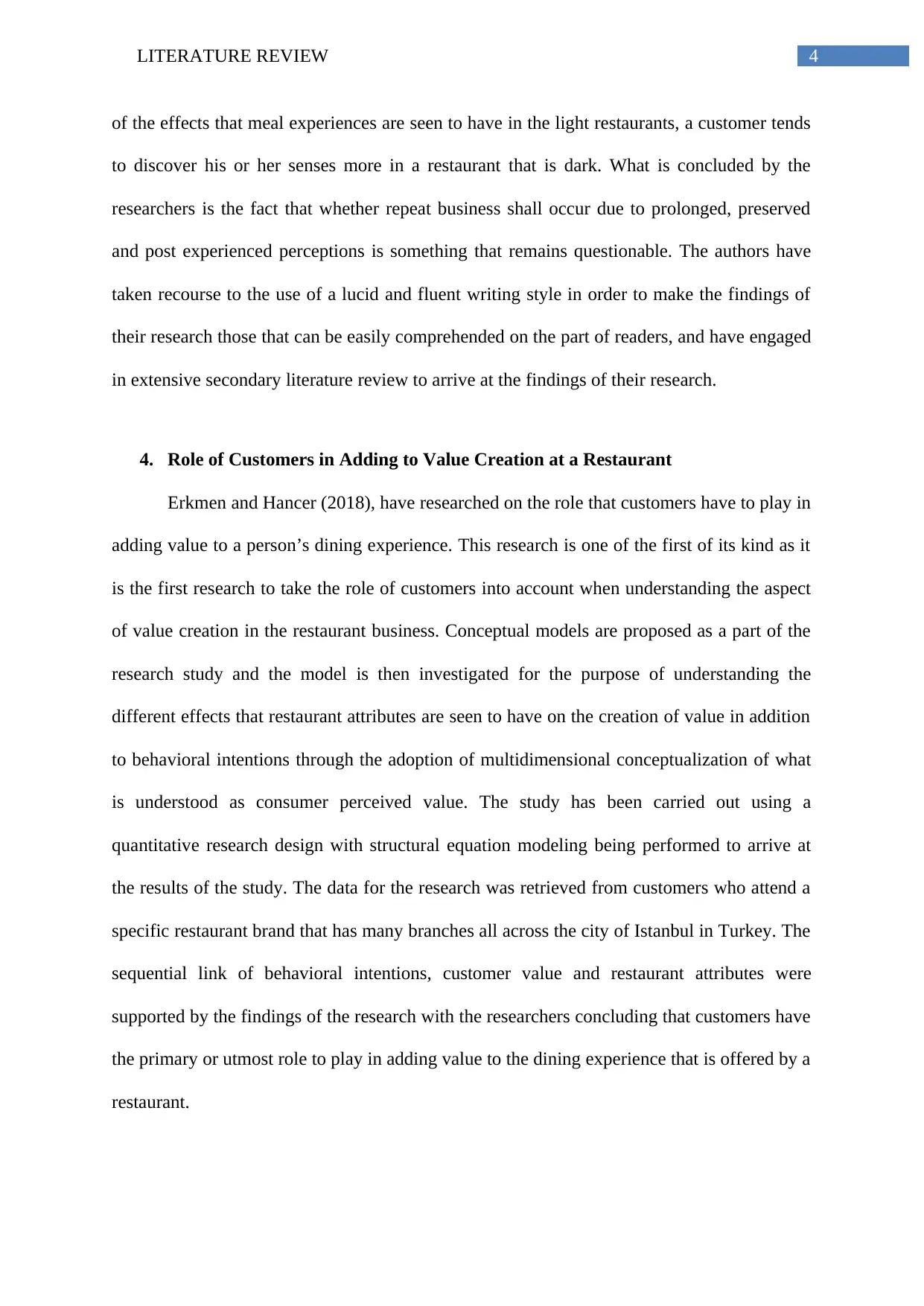
4LITERATURE REVIEW
of the effects that meal experiences are seen to have in the light restaurants, a customer tends
to discover his or her senses more in a restaurant that is dark. What is concluded by the
researchers is the fact that whether repeat business shall occur due to prolonged, preserved
and post experienced perceptions is something that remains questionable. The authors have
taken recourse to the use of a lucid and fluent writing style in order to make the findings of
their research those that can be easily comprehended on the part of readers, and have engaged
in extensive secondary literature review to arrive at the findings of their research.
4. Role of Customers in Adding to Value Creation at a Restaurant
Erkmen and Hancer (2018), have researched on the role that customers have to play in
adding value to a person’s dining experience. This research is one of the first of its kind as it
is the first research to take the role of customers into account when understanding the aspect
of value creation in the restaurant business. Conceptual models are proposed as a part of the
research study and the model is then investigated for the purpose of understanding the
different effects that restaurant attributes are seen to have on the creation of value in addition
to behavioral intentions through the adoption of multidimensional conceptualization of what
is understood as consumer perceived value. The study has been carried out using a
quantitative research design with structural equation modeling being performed to arrive at
the results of the study. The data for the research was retrieved from customers who attend a
specific restaurant brand that has many branches all across the city of Istanbul in Turkey. The
sequential link of behavioral intentions, customer value and restaurant attributes were
supported by the findings of the research with the researchers concluding that customers have
the primary or utmost role to play in adding value to the dining experience that is offered by a
restaurant.
of the effects that meal experiences are seen to have in the light restaurants, a customer tends
to discover his or her senses more in a restaurant that is dark. What is concluded by the
researchers is the fact that whether repeat business shall occur due to prolonged, preserved
and post experienced perceptions is something that remains questionable. The authors have
taken recourse to the use of a lucid and fluent writing style in order to make the findings of
their research those that can be easily comprehended on the part of readers, and have engaged
in extensive secondary literature review to arrive at the findings of their research.
4. Role of Customers in Adding to Value Creation at a Restaurant
Erkmen and Hancer (2018), have researched on the role that customers have to play in
adding value to a person’s dining experience. This research is one of the first of its kind as it
is the first research to take the role of customers into account when understanding the aspect
of value creation in the restaurant business. Conceptual models are proposed as a part of the
research study and the model is then investigated for the purpose of understanding the
different effects that restaurant attributes are seen to have on the creation of value in addition
to behavioral intentions through the adoption of multidimensional conceptualization of what
is understood as consumer perceived value. The study has been carried out using a
quantitative research design with structural equation modeling being performed to arrive at
the results of the study. The data for the research was retrieved from customers who attend a
specific restaurant brand that has many branches all across the city of Istanbul in Turkey. The
sequential link of behavioral intentions, customer value and restaurant attributes were
supported by the findings of the research with the researchers concluding that customers have
the primary or utmost role to play in adding value to the dining experience that is offered by a
restaurant.
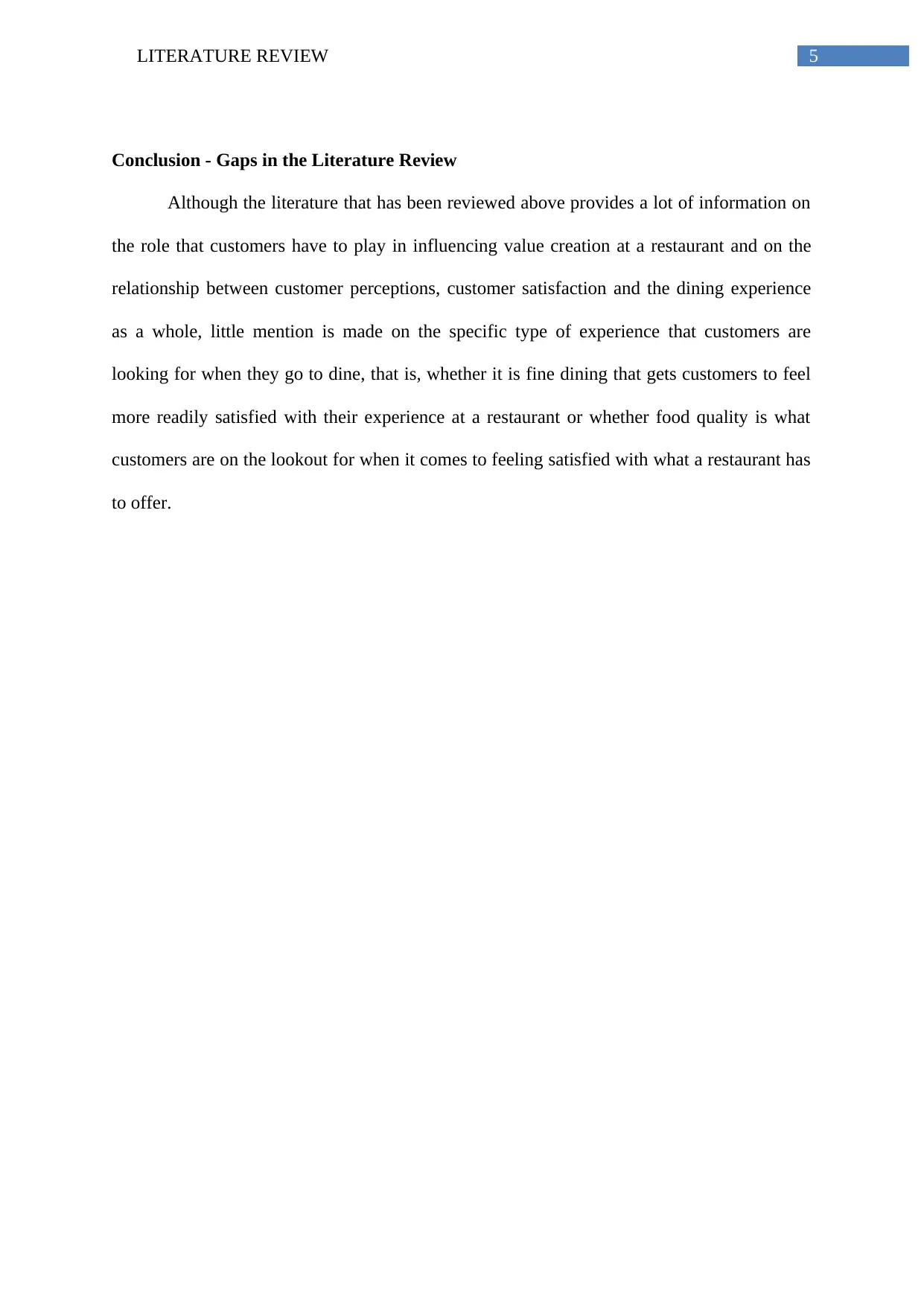
5LITERATURE REVIEW
Conclusion - Gaps in the Literature Review
Although the literature that has been reviewed above provides a lot of information on
the role that customers have to play in influencing value creation at a restaurant and on the
relationship between customer perceptions, customer satisfaction and the dining experience
as a whole, little mention is made on the specific type of experience that customers are
looking for when they go to dine, that is, whether it is fine dining that gets customers to feel
more readily satisfied with their experience at a restaurant or whether food quality is what
customers are on the lookout for when it comes to feeling satisfied with what a restaurant has
to offer.
Conclusion - Gaps in the Literature Review
Although the literature that has been reviewed above provides a lot of information on
the role that customers have to play in influencing value creation at a restaurant and on the
relationship between customer perceptions, customer satisfaction and the dining experience
as a whole, little mention is made on the specific type of experience that customers are
looking for when they go to dine, that is, whether it is fine dining that gets customers to feel
more readily satisfied with their experience at a restaurant or whether food quality is what
customers are on the lookout for when it comes to feeling satisfied with what a restaurant has
to offer.
⊘ This is a preview!⊘
Do you want full access?
Subscribe today to unlock all pages.

Trusted by 1+ million students worldwide
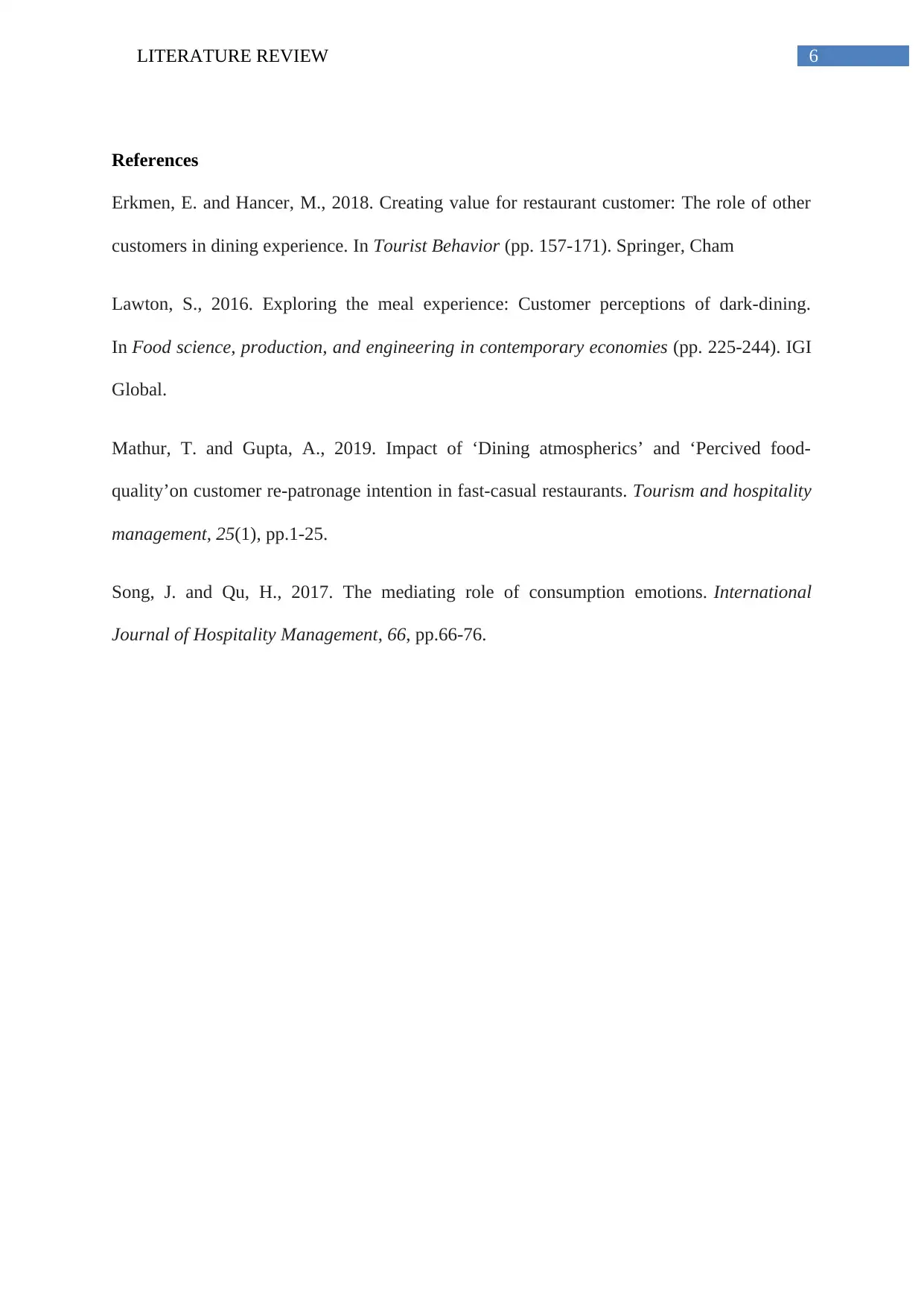
6LITERATURE REVIEW
References
Erkmen, E. and Hancer, M., 2018. Creating value for restaurant customer: The role of other
customers in dining experience. In Tourist Behavior (pp. 157-171). Springer, Cham
Lawton, S., 2016. Exploring the meal experience: Customer perceptions of dark-dining.
In Food science, production, and engineering in contemporary economies (pp. 225-244). IGI
Global.
Mathur, T. and Gupta, A., 2019. Impact of ‘Dining atmospherics’ and ‘Percived food-
quality’on customer re-patronage intention in fast-casual restaurants. Tourism and hospitality
management, 25(1), pp.1-25.
Song, J. and Qu, H., 2017. The mediating role of consumption emotions. International
Journal of Hospitality Management, 66, pp.66-76.
References
Erkmen, E. and Hancer, M., 2018. Creating value for restaurant customer: The role of other
customers in dining experience. In Tourist Behavior (pp. 157-171). Springer, Cham
Lawton, S., 2016. Exploring the meal experience: Customer perceptions of dark-dining.
In Food science, production, and engineering in contemporary economies (pp. 225-244). IGI
Global.
Mathur, T. and Gupta, A., 2019. Impact of ‘Dining atmospherics’ and ‘Percived food-
quality’on customer re-patronage intention in fast-casual restaurants. Tourism and hospitality
management, 25(1), pp.1-25.
Song, J. and Qu, H., 2017. The mediating role of consumption emotions. International
Journal of Hospitality Management, 66, pp.66-76.
1 out of 7
Related Documents
Your All-in-One AI-Powered Toolkit for Academic Success.
+13062052269
info@desklib.com
Available 24*7 on WhatsApp / Email
![[object Object]](/_next/static/media/star-bottom.7253800d.svg)
Unlock your academic potential
Copyright © 2020–2025 A2Z Services. All Rights Reserved. Developed and managed by ZUCOL.




